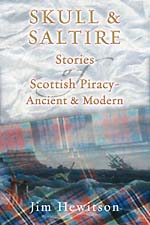The History of Maritime Piracy
Cindy Vallar, Editor & Reviewer
P.O. Box 425, Keller, TX 76244-0425
Cindy Vallar, Editor & Reviewer
P.O. Box 425, Keller, TX 76244-0425
|
|
|
|
|
|
Books for Adults - Nonfiction

![]()
![]()
![]()
![]()
![]()
Three names are most oft thought of when speaking of Scottish piracy. One was a pirate for certain – John Gow. Another wasn’t a pirate at all, but was hanged for piracy on trumped-up charges after the failure of the Darien Expedition – Captain Green. The most notorious, however, was Captain William Kidd, who may or may not have committed piracy. These are but a few of the Scots that Jim Hewitson discusses in his popular history about the sea rogues who preyed the oceans. He admits to being neither a historian nor a descendant of pirates, but his interest in piracy and living on Papa Westray in the Orkneys have led him to research this fascinating subject and write this book.Divided into thirteen chapters, Skull & Saltire covers all time periods of piracy in and around Scotland, as well as pirates be they born in Scotland or descended from Scottish emigrants. He also makes mention of two more recent prosecutions of pirates – the Mary Craig case (1970s) and the Jane case (1821). Interspersed throughout is information on Scots who encountered pirates – including Alan MacLean, a sailor shot by pirates off Somalia in 1999 – and general information about pirates and how they lived. He also includes John Paul Jones, the father of the American Navy, because, as was so often the case throughout history, one might be a hero to one group of people, but a pirate to another. Such was the case with Jones during the American Revolution. The British considered him a pirate for his daring raids along the Scottish coast and against British ships, but the Americans considered him a privateer and a heroic seaman who fought for the cause of liberty against a tyrant king.
Of course, the world’s most famous contributions to the swashbuckling image of the pirate that we recognize today come from three Scots: Sir Walter Scott, Robert Louis Stevenson, and J. M. Barrie. Hewitson does a commendable job separating out the romantic myths from reality, and doing so from the first records of piracy in Scotland (dating back to Dalriada and the Vikings) through the Golden Age of Piracy (1690-1730) and beyond. Occasionally, hidden amongst the text are trivial facts connected to piracy and Scotland, such as the fact that Thomas Spotswood, the Governor of Virginia who sent Lieutenant Robert Maynard to hunt down Blackbeard, was descended from an illustrious Scottish family. Or perhaps the tale of Helen Gloag, a Scottish lass with red hair and emerald eyes, will capture your imagination; a captive of pirates, she caught the eye of the Sultan of Morocco and became his empress.
The author also includes a chapter that really hasn’t anything to do with piracy in its true sense, but still makes for interesting reading. He calls these individuals “piratical peoples” and they include the wreckers, the press gangs, and the skippers of the Clyde steamships. His inclusion of Sir Francis Drake and a possibility that he was drunk during the Spanish Armada is a bit suspect, even though he ties it to an earlier incident involving the English attempt to kidnap Princess Margaret and James I of Scotland on their way to France where she was to wed the Dauphin.
This intriguing and spellbinding account of Scottish piracy is well researched, although a few inaccuracies do occur. These, however, are minor fallacies that fail to detract from a worthy account of this oft-neglected aspect of piracy. Skull & Saltire is, perhaps, the most complete introduction to Scottish pirates published to date, and Hewitson does include a list of his sources so others may explore the topic further. The index is also helpful, and often a missing part of popular histories. “Pieces of Eight,” the last section of the book, may be the true pirates’ treasure, for it contains “did you know” facts to pique the reader’s imagination and curiosity.
Book Review Copyright ©2006 Cindy Vallar
Home Pirate Articles Pirate Links Book Reviews Thistles & Pirates